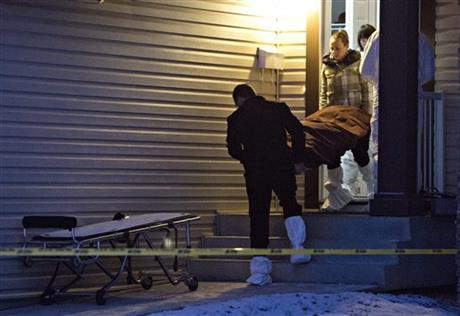
A man with a lengthy criminal record killed six adults and two young children before taking his own life in Edmonton in what the police chief on Tuesday called the western Canadian city’s worst mass murder.
Edmonton Police Chief Rod Knecht told a news conference late Tuesday night that there was no suggestion of gang involvement and said the motive for the “senseless mass murder” appears to have been “planned and deliberate” domestic violence.
“It’s terrible for the city,” Knecht said. “The scene … has been described as chaotic, horrific. Particularly when there’s children involved, it has a tremendous impact on our folks.”
Knecht did not release the name of the suspect, but said the man was well-known to police and had a criminal record dating back to September 1987.
Cindy Duong, 37, was fatally shot in a home in south Edmonton on Monday, while two men and three women between the ages of 25 and 50, and a girl and a boy — both under the age of 10 — were found dead a few hours later at a home in the northeast.
The suspect was found dead by his own hand in a restaurant in the Edmonton bedroom community of Fort Saskatchewan on Tuesday morning. A police tactical team had surrounded the area and reportedly smashed through the front of the restaurant with a vehicle before finding the suspect dead.
Duong’s body was found around 7 p.m. Monday when police responded to a report of a man entering the south-side home, opening fire and fleeing, Knecht said.
An hour and a half later, officers responded to reports of a suicidal man at a northeast residence in a quiet cul de sac, the same home where the suspect had been arrested in November 2012 and charged with domestic and sexual assault.
Family members reported in the call that the man was “depressed and over-emotional.”
When officers arrived, no one answered the door, Knecht said. They searched the exterior of the home but found nothing overtly suspicious and did not go inside.
“We can’t just arbitrarily go into that residence,” explained the chief.
Hours later police were contacted by a second person and returned to the residence. When they went inside, they found a scene of carnage with seven bodies.
Neighbor Moe Assiff said he saw officers come out and talk to a woman sitting with a man in a white car outside the house.
“She just let out a hysterical scream. It was eerie,” Assiff said. “She was screaming about her kids: ‘My kids! The kids!,’ grabbing her hair and trying to pull her hair out. The cops then ushered her down the road into a police cruiser.”
Outside the restaurant where the suspect’s body was found, police found a parked black SUV that they say was seen near the location of the first shooting. Knecht said the suspect had a business interest in the restaurant, but would not say if he was the owner.
Investigators have determined the 9 mm handgun used in the killings was a registered weapon that had been stolen in Surrey, British Columbia, in 2006.
In Edmonton, a city of 878,000 people, mass murders are extremely rare. Knecht said the case was the worst mass killing in the city since at least 1956, when six people were murdered.
John Etter Clark, a provincial politician who served as a member of the Legislative Assembly of Alberta for four years, killed his wife, son, three daughters and an employee of their family farm before taking his own life in 1956. Clark had been suffering from frequent nervous breakdowns in the years before the killings.



